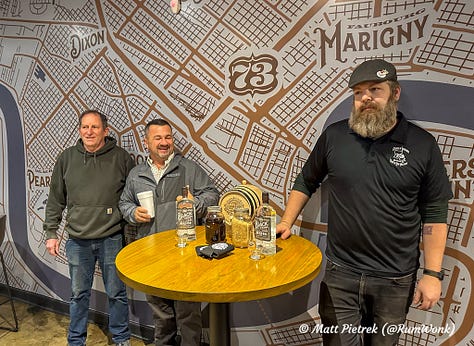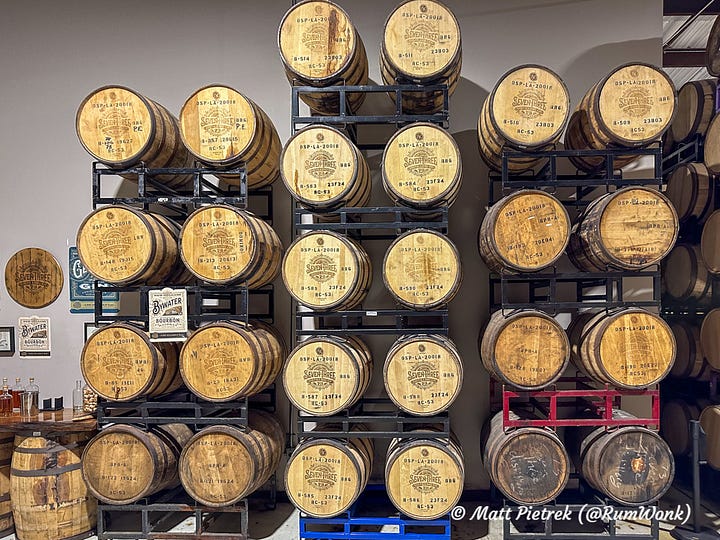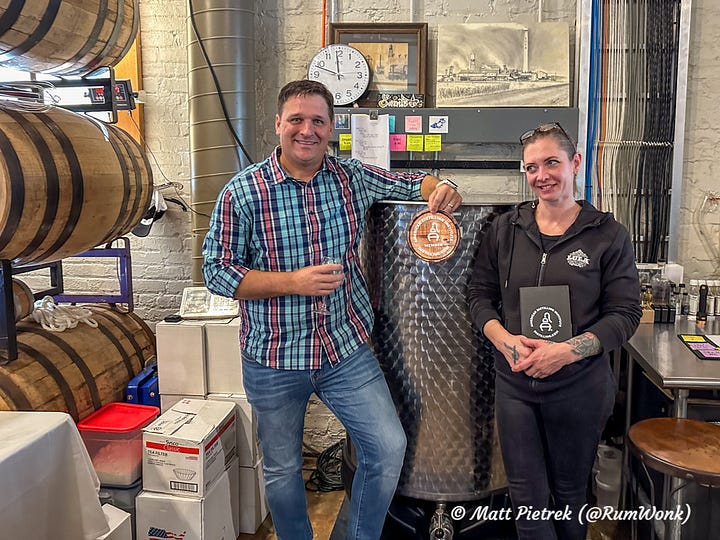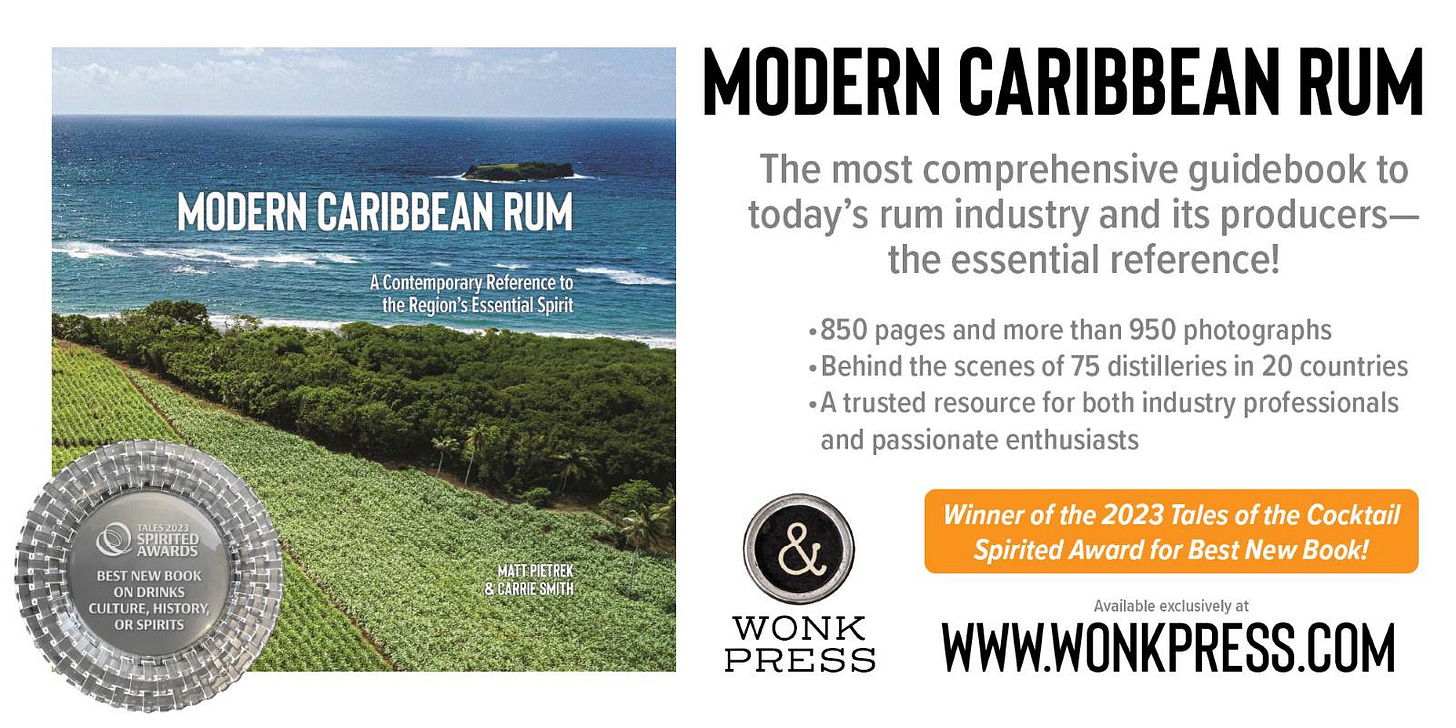Louisiana Rum - Part 1 - Overview
As a Louisiana resident for nearly five years, I’ve somehow not written anything about my home state’s rums. My partial justification is that I was writing Modern Caribbean Rum during my first three years here. However, a recent press trip of over a dozen Louisiana distilleries in 4 days, and co-sponsored by the Louisiana Distillers Guild, allowed me to rectify this shortcoming.
What follows is my big picture take on Louisiana rum making—past and present, plus capsule synopses of several distilleries I visited. Subsequent posts will cover additional distilleries on my tour.
Looking Back
With 17 distilleries making a stylistically diverse range of rums, the good name of Louisiana rum has traveled well beyond just the United States. However, Louisiana rum had a markedly different reputation during America’s Civil War.
Google Books is chock full of obscure books like History of the First Regiment, Alabama Volunteer Infantry C.S.A., where this passage resides:
Louisiana rum was the peculiar bane of the Port Hudson Army. The sugar planters, being unable to sell their sugar, converted it into this accursed liquid. Details from our regiment were sent out to destroy these distilleries. We were also placed as police guards on all roads leading to distilleries, and ordered to seize and confiscate the rum being brought into our lines. Many gallons were captured every night and brought to our guardhouse and poured out on the ground. Our old comrades will remember how the thirsty men would dip it up in cups, or drink it out of the ditches until driven off by the guards.
The Union army had a similar take on the state’s rum, as noted In The Fourteenth Regiment Rhode Island Heavy Artillery (colored) in the War to Preserve the Union, 1861-1865:
“[…] I think I never knew of any stimulant more demoralizing in its way, than Louisiana rum. This fiery fluid would arouse all the furies in a man when it had him under its control.”
Mercifully, today’s Louisiana rum is vastly better than it was 150 years ago. What hasn’t changed is ready access to world-class agriculture, courtesy of the fertile wetland soils created by the constant flooding of the Mighty Mississippi.
Agricultural Advantage
The fact that Louisiana has 17 rum-makers in a state with less than 5 million residents may surprise you until you know it recently overtook Florida as the US’s largest sugarcane grower. The proximity to sugar mills gives Louisiana distilleries substantial cost advantages. Louisiana’s distillers can pick up a load of fresh cane juice, molasses, or raw sugar from a local sugar mill. In contrast, many other distilleries rely on expensive molasses transported over great distances. The close proximity to sugar mills also enables Louisiana distillers to make cane juice rum, aka “agricole-style” rum.
Louisiana Distilleries in Overview
Most of Louisiana’s 17 distilleries make rum alongside other spirits like whisky, gin, and vodka. Only a handful focus primarily or entirely on rum:
Bayou
Roulaison
Wildcat Brothers
Happy Raptor
The “average” Louisiana rum maker is a small craft distillery tucked into a repurposed commercial building or warehouse. As is common with craft distilleries, the revenue from distilling alone isn’t enough to keep the lights on, so many also include a bar or restaurant as part of the business.
The rums made by Louisiana distilleries encompass a wide swath of sizes, styles and approaches to their source materials. A handful of distilleries make cane juice rum, but only NOLA’s Porchjam distills it exclusively from cane juice. Cane juice must be fermented within a few hours of crushing, or undesirable flavors will appear in the rum. With only a 3-month harvest, distilleries can only make cane juice rum three months out of the year. Thus, nearly all of Louisiana’s rum-making distilleries use some combination of molasses and raw sugar for most of their ferments.
While using raw sugar crystal is seen in some quarters as a shortcut, Louisiana’s sugar mills are so efficient at extracting sugar that their blackstrap molasses has a relatively low sugar content. This creates fermentation challenges, which can be worked around by supplementing the molasses with raw sugar from the same mill.
Size-wise, Louisiana’s rum makers range from Atelier Vie with a single, 30-gallon pot still, to Bayou, which distills 4,000-gallon batches with three pot stills. All the state’s distilleries use batch (pot) stills, as none other than Bayou makes rum on a scale where continuous distillation makes sense. (Continuous distillation is significantly more complicated than batch distilling.) And while some distilleries have gleaming stills from well-known still makers, others were handmade by the distillers themselves.
NOLA visitors desiring a distillery tour have five options within a reasonable car-share ride distance. Of those five, Roulaison is likely the best bet for hard-core rum aficionados. Most of the state’s other distilleries are an hour or more away by car.
Capsule Summaries
Below are my brief notes on eight distilleries from the aforementioned press trip; future posts will cover additional Louisiana rum distilleries. My notes are more rum production focused than the typical distillery visit writeup as that’s what my readers expect. There are no tasting notes or reviews included as tastes are subjective.
Seven Three Distilling





Walking distance from the French Quarter, Seven Three Distilling is a medium-sized craft distillery with a well-polished guest experience, starting with its well-tailored reception area and gift shop. A spacious tasting room doubles as an event space. The distillery itself is behind closed doors in the rear of the building. Distillation geeks will have a rare opportunity to gawk at a Figgins reciprocating still —essentially two kettles plumbed to a shared rectifying column. Each kettle holds 250 gallons, and the rectifying column holds eight plates.
Seven Three’s rum mash consists of molasses and raw sugar sourced from the Lula Westfield sugar mill – two parts molasses to one part sugar. Commercial yeast and a week-long fermentation yield a wash at 8% ABV. Distillation from the reciprocating still is in the 87-90% ABV range. Rum to be aged enters the barrel at around 60% ABV.
Brands: Black Pearl
Website: Seven Three Distilling Co.
Happy Raptor Distilling





From the sidewalk, Happy Raptor Distilling resembles any number of small, quirky bars or coffee shops. But tucked away in the back is a small distillery that creates the 504 rum lineup. (504 is the New Orleans area code.)
Molasses and raw sugar from the Lula sugar mill serve as Happy Raptor’s source materials. After a week-long ferment, the wash goes into “Big Bertha,” a handmade pot still with a thumper tub. The first distillation (“stripping run”) is at 30% ABV, and the second (“spirit run”) is at 70% ABV.
Happy Raptor focuses on flavored rums, including Bananas Foster, King Cake, Coffee, and Hibiscus. However, no sugar is added, making them flavored rums rather than liqueurs. The open-topped infusion tanks are two steps from the still, and if you ask nicely, they’ll pull out some of the infusion materials with a paddle for you to sample. The company says they’re inspired by the rhum arrange made in the French Overseas Territories. There’s no cask aging program currently; however, the 504 Gold Rum spends four weeks infusing with French and American oak chips.
Brands: 504
Website: Happy Raptor Distilling (504rum.com)
Lula Restaurant Distillery





While many craft distilleries host a small bar or pub, Lula Restaurant and Distillery is unabashedly a large-scale, high-ceilinged dining establishment that happens to have a gleaming CARL still on display behind glass. The restaurant serves all the rich foods you’d expect to find in New Orleans, like crawfish queso, sugarcane pork skewers, crawfish mac-n-cheese, and chicken and sausage gumbo.
A 2015 change in state law was required to enable a distillery and restaurant to operate in the same space, and all the distillery’s products are sold onsite or used by the restaurant. Lula’s namesake is the Lula-Westfield sugar mill, which supplies the molasses and raw sugar for the distillery.
Brands: Lula Rum
Atelier Vie



When it comes to small, quirky operations, Atelier Vie takes a backseat to no one. Located within a former produce warehouse converted to commercial lofts, owner/distiller Jed Hass creates a vast cornucopia of different spirits. Every inch of Atelier Vie is dedicated to production or storage, so a fancy reception area, tasting room, and gift shop aren’t on the agenda here.
Hass uses 100% molasses with a sugar content of around 45% and a two-week fermentation. The operational heart of Atelier Vie is its tiny-but-mighty 30-gallon pot still. Calio rum currently comes in unaged, aged, and 4-year bottled-in-bond variations. Hass also makes whiskies, brandies, gins, and various liqueurs like Gumbo Noir, a coffee-infused spirit.
Brands: Calio
Website: Creative Distilling in New Orleans (ateliervie.com)
Borasso Spirits




The vibe of Borasso Spirits is best described as “Cool hangout space in an industrial warehouse just steps from a freeway ramp.” Therein, owner/distiller Ewan Willy has created an operation equal parts bar, artist loft, performance space, and distillery.
Borasso’s unaged rum uses local molasses fermented for 4 to 5 days, then twice distilled on a small pot still. Willey also makes two gins: Southeast Asian and Tree, which uses locally sourced Cypress, Pine, and Magnolia leaves.
Brands: Borasso
Website: Borasso Spirits
New Orleans Distillers





Despite its name, New Orleans Distillers is located in a former canning factory alongside a canal in Harvey, Louisiana. Head distiller and general manager Adrie de Wall uses them to create a diverse portfolio of rum, rye, single malt whisky, vodka, and various liqueurs. New Orleans Distillers makes up to 500 bottles per day at peak capacity.
To make rum, de Wall first pasteurizes A- and B-grade molasses for an hour. Fermentation uses 4 different yeast strains and is temperature controlled. Distillation is in two pot stills in the center of a very substantial space — there’s plenty of room for future expansion. One of the stills is topped with a 7-plate rectifying column, and rum comes off the still at around 73% ABV.
Without traffic, New Orleans Distillers is a 25-minute or so drive from the French Quarter and includes crossing the Mississippi River. Its Mermaid brand name is a shoutout to the canned fish brand previously produced here.
Brands: Mermaid, Piratus, Raider
Website: Facebook page
Bayou Terrebonne





Located in a former dried shrimp packing plant in Houma, Bayou Terrebonne leans heavily on its bayou and bootlegger heritage. Owner/distiller Noah Lirette is the great-grandson of a prohibition-era “bootlegger.” The building’s interior retains the character of its roots, and visitors can walk right up to the two handmade stills tucked away in a corner.
Unlike many small craft distilleries that make vodka and gin, Bayou Terrebone’s heart is clearly in the whisky and rum space. Beyond Hardscrabble rum, Lirette also makes bourbon and unaged corn whiskey.
Bayou Terrebone’s rum mash recipe blends 80% raw sugar crystals and 20% B-grade molasses. Fermentation takes 7-10 days, and distillation is via separate stripping and finishing stills, 76 gallons and 24 gallons, respectively.
Brands: Hard Scrabble Gulf Coast Rum
Wildcat Brothers Distilling




Tucked away in Gator Cove — a section of Lafayette, LA — Wildcat Brothers started distilling in 2011 and is Louisiana’s second licensed distillery.
Wildcat Brother’s source material is 100% raw sugar from the M.A. Patout and Son mill. Fermentation uses an active dry yeast, is temperature controlled, and lasts for 3-5 days. “Lula,” a handmade 100-gallon pot still, once handled the distilling chores but has been (mostly) replaced by “Zula,” a modern 550-gallon pot still topped with a 4-plate rectifier. Aging is in a variety of cask sizes, ranging from 10- to 53-gallons.
Wildcat Brother’s flagship Noire rum combines rum aged for 5 years in ex-Buffalo Trace casks with younger rums aged with ancestral fruit tree staves — cherry, pear, persimmon, and plum, plus hickory.
Brands: Noire (aged), Sweet Crude (unaged), Fifolet (spiced)
Website: Wildcat Brothers
But wait! There’s more! Future Rum Wonk posts will cover additional Lousisana rum distilleries.





Great article... I'm looking forward to part two. Matt, I know the distillery has closed and when it was distilling it did more than rum... do you have any opinion about what Donner Peltier used to distill? I still have a few bottles that I use sparingly. Thanks.
As usual, Matt, a fantastic and informative piece. I enjoyed it.